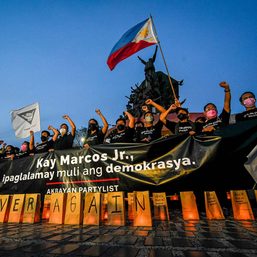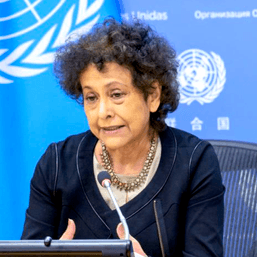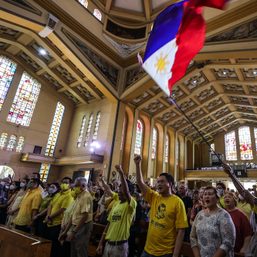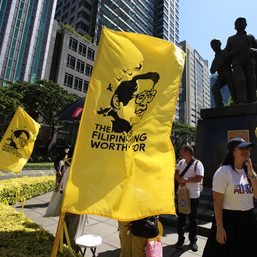SUMMARY
This is AI generated summarization, which may have errors. For context, always refer to the full article.

Note: A Thousand Cuts was nominated for best documentary in the Gawad Urian 2021. This review was written on October 18, 2021 by UP Professor Emeritus Nicanor G. Tiongson, founding member and former chair of the Manunuri ng Pelikulang Pilipino, for the Gawad Urian program and website. The author wishes to share his thoughts on the film with the general public on the occasion of its winning the Emmy for Outstanding Social Issue Documentary and the conferment of an honorary doctorate on Maria Ressa by the Ateneo de Manila University.
For Filipinos who have been living with fear, disgust, and anger under the shadow of Duterte’s murderous war on drugs, his wanton and unconstitutional suppression of free speech, and his deadly war on journalists and the truth, this Ramona Diaz documentary on Maria Ressa and Rappler’s relentless struggle to expose the abuses of the regime comes as a much-needed ray of hope, a source of enlightenment, and a call to reaffirm one’s commitment to truth and democracy.
Award-winning documentarist Diaz (Imelda, the Kingmaker, The Motherland) tracks the ups and (mostly) downs of Ressa and her team’s work as professional journalists for four years, from June 2016 when Duterte came to the presidency of the Philippines to June 2020 when Ressa was found guilty in a cyber libel case whipped up by the Department of Justice against her, retroactively using a cybercrime law on her case. Chronologically, the film documents the attacks made on her and Rappler, both in court by government officials and in social media by an army of paid trolls, accusing Rappler of being an “outlet of fake news,” an American-owned company with foreign interests, a bunch of mercenaries or ACDC (attack-collect-defend-collect) hacks, and secret members of Matrix, the group supposedly plotting a coup against Duterte. These assaults are presented in relation to larger events which may explain the timing, context or purpose of the diatribes – the State of the Nation (SONA) addresses from 2017 to 2019; the senatorial elections of 2018, where all opposition candidates were routed; the interviews of Duterte by Ressa and Ranada, and the documentarist’s own interviews with police general “Bato” de la Rosa who executed the first phase of the war on drugs, and Mocha Uson, dance entertainer-turned-“queen of fake news,” who runs the vast system of disinformation for Duterte. While the docu graphically explains how fake news are started by 26 sites and then disseminated to three million accounts, it also reveals Ressa and Rappler’s growing network of support in the Philippines and abroad.
As a documentary, the film effectively employs the cinema direct technique, avoiding a voice over or narrator and, instead, shooting scenes and then editing them so that they can “speak for themselves.” Wisely, Diaz also avoids the usual talking heads format, which usually becomes stilted and boring, preferring to follow her subjects with a hand-held camera in their daily activities – Ressa as she meets with her staff, arrives at the airport and is arrested, documents on her cellphone the panel discussion where she is lauded by George Clooney for “shining a light,” and explains to a group of Filipino progressives how government is subjecting democracy to a thousand small cuts, that will weaken and eventually kill her. This technique is bound to result in some awkward angles or shots, but surprisingly these only help to underscore the actuality of these scenes. Sound is recorded live and clearly throughout. Non-diegetic music is dispensed with to preserve the realistic tone. At most, ominous drone sounds occasionally underscore the gravity of specific incidents.
A signal achievement of the documentary is that it makes palpable for the audience the effects of Duterte’s attacks and threats on the persons of the journalists themselves, whose job it is to find ways and means to get to the truth at the risk of their own lives and freedoms. Pia Ranada, who irked Duterte with her pointed questions about Bong Go’s alleged corruption, was publicly shamed in front of Malacañang officials and journalists when the president accused her and Rappler of disseminating news that are “rife with innuendoes and pregnant with falsity.” Patricia Evangelista recounts her experience with two EJKs in one neighborhood in one night, which had such a chilling effect on her that she became paranoid about everything for days. Another young journalist, whose beat covers the small barangays which are the targets of tokhang-happy policemen, says the images of bloody bodies lying on sidewalks are so overwhelming they haunt him even in his dreams. These experiences might have caused these young idealistic journalists to have second thoughts about their profession, except that they had a leader whose fearlessness and fortitude were a constant source of strength and inspiration.
Maria Ressa grew up in New Jersey, USA, with her Filipino immigrant family and had to work 150% to be accepted by her schoolmates. After the EDSA revolt of 1986, she decided to live and work in the Philippines to help in rebuilding a country ravaged by Marcos and his cronies. She worked as CNN bureau chief in the Philippines and then in Indonesia. In 2012, she established Rappler as an independent online website based in the Philippines. A no-frills, down-to-earth person wearing close-cropped hair, rimless glasses, and colorful business suits, Ressa followed Duterte’s rise to power and his first four years in Malacañang, soon earning the special ire of the President because she pointed out contradictions in his role as president and his kill, kill, kill strategy for eliminating drugs, and exposed the alleged corruption and incompetence of Duterte’s ministers, which belied the President’s posturing as a champion of integrity and good governance. Duterte’s henchmen in social media harassed her with threats of bankruptcy, violence, and rape, while the government filed one case after another against her, raising the bail amount each time.
But these attacks only made her even more resolute, her journalism even more uncompromising, even as it raised her higher in the estimation of progressive pro-democracy organizations abroad. To her sister’s fear for her safety, Ressa replied: Think of the worst that can happen and embrace it; then you conquer your fear. And your self-pity, one may add. Her acceptance of the worst has made Ressa unshakeable and unsinkable. In these times of darkness, Ressa is not only a rock offering safety and stability, but also the shining light standing on that rock, beaming hope to all freedom-loving Filipinos.
But Ressa herself would be the first to say that Rappler’s success is not hers alone. She has been blest with a team of similarly iron-willed and principled journalists, both veteran and neophyte and mostly women, who seem undeterred by threats on their lives, among them, Glenda Gloria, Chay Hofileña, Lilibeth Frondoso, Gemma Mendoza, Miriam Grace Go, Pia Ranada, Patricia Evangelista, and Rambo Talabong. Moreover, she has earned the respect of international organizations who have expressed solidarity with her advocacies as well as outrage at Rappler’s ordeals under a fascistic regime. The 2018 Time Magazine award, which acclaimed her as one of four “guardians of the truth,” and the endorsement of her cause by world figures like George and Amahl Clooney may not have prevented subsequent arrests and harassment, but they have certainly brought her struggle and that of the Philippines to the attention of the world. This kind of international support for journalists stems from a conviction that every country in the world today is connected to what Ressa calls a “global system of disinformation.” Journalists around the world are an endangered species and we neglect them at the cost of our own ruin. Adapting Martin Niemoller’s famous quote on the apathy which empowered Hitler’s regime, Ressa says, “First they came for the journalists, and nothing was heard of ever since.”
A Thousand Cuts becomes even more significant when seen as part of a larger movement against authoritarianism today. After the Aquino assassination in 1983, beleaguered journalists banded with progressive artists and all freedom-loving Filipinos to combat the Marcos dictatorship. Then, filmmakers, especially those of Asia Visions, documented the abuses of the conjugal dictatorship and the protest movement against the Marcos regime that would be suppressed in the Marcos-controlled media, in films like The Arrogance of Power, Signos, and Lakbayan. Today, embattled journalists must join ranks with like-minded artists who have already created works denouncing EJK, such as the award-winning films Aswang, Buy Bust, and Watch List and the plays Tao Po! and RD3RD; plays unmasking the techniques for rapidly disseminating fear and fake news, such as Game of Trolls, Sincerity Bikers Club, and Pilipinas Kong Mahal with all the Overcoat; and works that resist historical revisionism by reviving the horrors of Martial Law, such as the films ML, Respeto and Liway, and the plays Buwan at Baril, Pagsambang Bayan, and Indigo Child. A Thousand Cuts now takes its preeminent place among these works of protest against the Duterte regime.
Since her conviction in June 2020, Ressa and Rappler have continued, and have even stepped up, their fight for truth and democracy, as in their coverage of the billions allegedly lost to corruption during the tenure of Duterte-appointed officials of PhilHealth and the Senate investigation into more billions of pandemic funds paid to a company called Pharmally, which allegedly was not even qualified to bid but nonetheless received the payment in advance of the delivery of PPEs. There is no doubt that Rappler will work doubly hard to keep the people properly and promptly informed on the issues, fake or real, that are being hurled at each other by trapos (traditional politicians) in the run for the presidential and senatorial elections of 2022. Meanwhile, Ressa’s tireless and intrepid pursuit of the truth has just earned her the highest recognition, the Nobel Peace Prize (shared with another journalist), the first ever awarded to a Filipino, which will go a long way in reaffirming Ressa and Rappler’s credibility and the validity and timeliness of their continuing struggle for freedom and democracy. The film’s end song speaks for Ressa and Rappler: “A thousand cuts won’t be enough/ to keep my fists in these cuffs.” – Rappler.com
Add a comment
How does this make you feel?



![[WATCH] Bamban POGO scandal: There’s a bigger fish than Alice Guo](https://www.rappler.com/tachyon/2024/07/inside-track-tcard-bamban-pogo.jpg?resize=257%2C257&crop=435px%2C0px%2C1080px%2C1080px)
![[Vantage Point] China’s silent invasion of the Philippines](https://www.rappler.com/tachyon/2024/07/TL-china-silent-invasion-july-16-2024.jpg?resize=257%2C257&crop=318px%2C0px%2C720px%2C720px)
![[DECODED] The Philippines and Brazil have a lot in common. Online toxicity is one.](https://www.rappler.com/tachyon/2024/07/misogyny-tech-carousel-revised-decoded-july-2024.jpg?resize=257%2C257&crop_strategy=attention)




















![[Just Saying] Ted Failon, press freedom, and the Supreme Court](https://www.rappler.com/tachyon/2024/07/20240709-ted-failon-press-freedom-supreme-court.jpg?resize=257%2C257&crop=296px%2C0px%2C720px%2C720px)

![[OPINION] Rodrigo Duterte and his ‘unconditional love’ for China](https://www.rappler.com/tachyon/2024/04/rodrigo-duterte-xi-jinping-august-2019.jpeg?resize=257%2C257&crop=91px%2C0px%2C900px%2C900px)

![[The Slingshot] Lito Patay’s 4 hours and 38 minutes of infamy](https://www.rappler.com/tachyon/2024/07/Lito-Patay-4-hours-infamy-July-19-2024.jpg?resize=257%2C257&crop=233px%2C0px%2C720px%2C720px)
There are no comments yet. Add your comment to start the conversation.